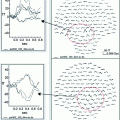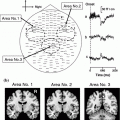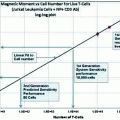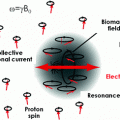Fig. 1
Spatiotemporal distribution of oscillatory changes during hand grasping, a the location of the implanted electrodes, b a time-frequency spectrogram, c spatial distribution of high gamma band activities (left) and alpha and beta desynchronizations (right)
3 Neuromagnetic Neural Decoding
Neural decoding using neuromagnetic signals is still a relative newcomer compared to electrocorticographic decoding. Magnetic amplitude as a parameter decodes upper limb movements with high accuracy, while decoding using oscillatory activities does not allow for high accuracy (Sugata et al. 2012a, b). This is probably because it is difficult to pick up weak gamma band activities using MEG. Therefore, one of the technological challenges in neuromagnetism is to establish a method for neuromagnetic measurement of high gamma band activities on a single trial basis. This would enable not only accurate neural decoding using MEG, but would also allow phase analyses revealing coupling phenomena between the gamma and other bands.
References
Goto T, Hirata M, Umekawa Y, Yanagisawa T, Shayne M, Saitoh Y, Kishima H, Yorifuji S, Yoshimine T (2011) Frequency-dependent spatiotemporal distribution of cerebral oscillatory changes during silent reading: a magnetoencephalograhic group analysis. NeuroImage 54:560–567CrossRef
Stay updated, free articles. Join our Telegram channel

Full access? Get Clinical Tree








